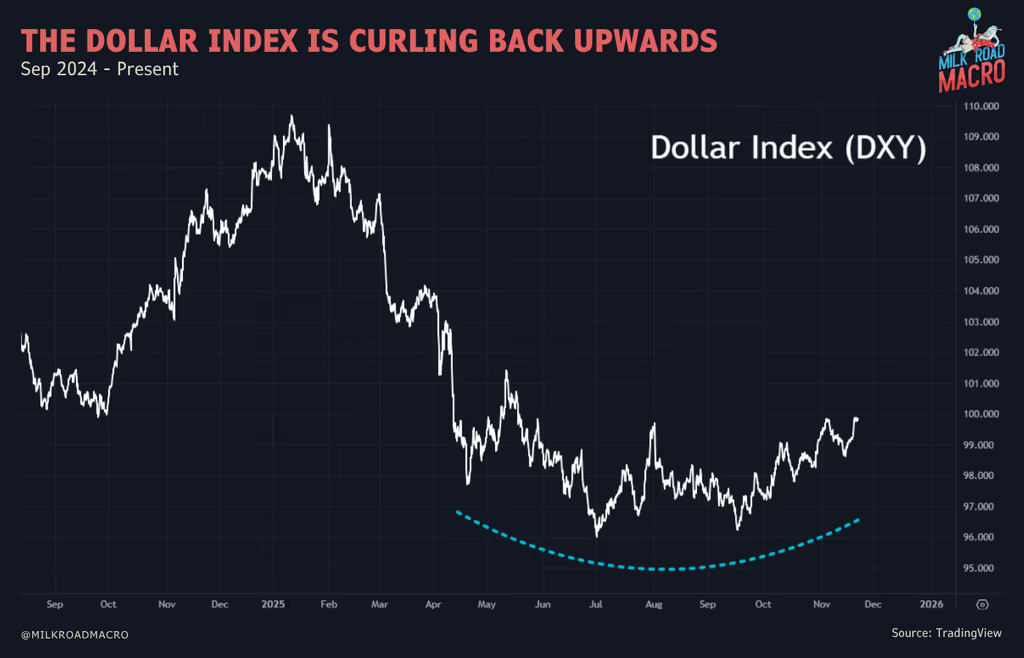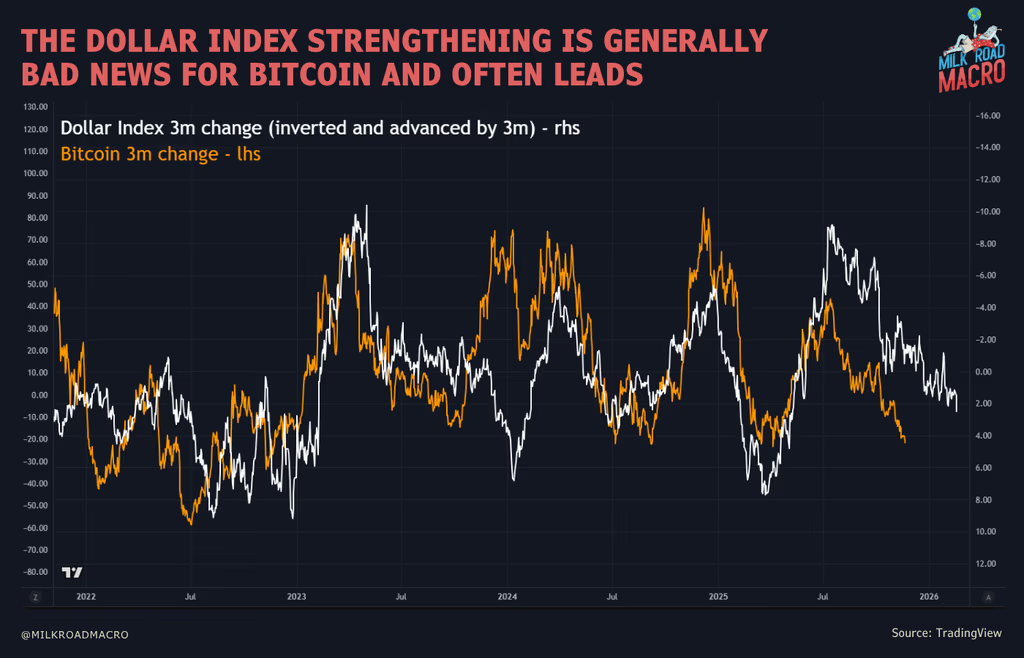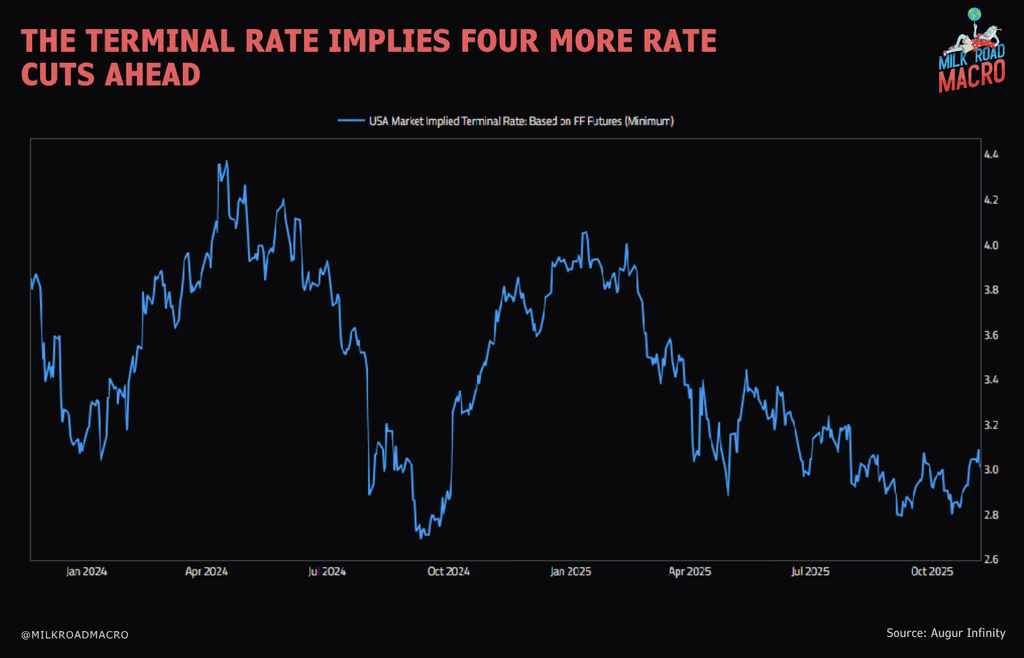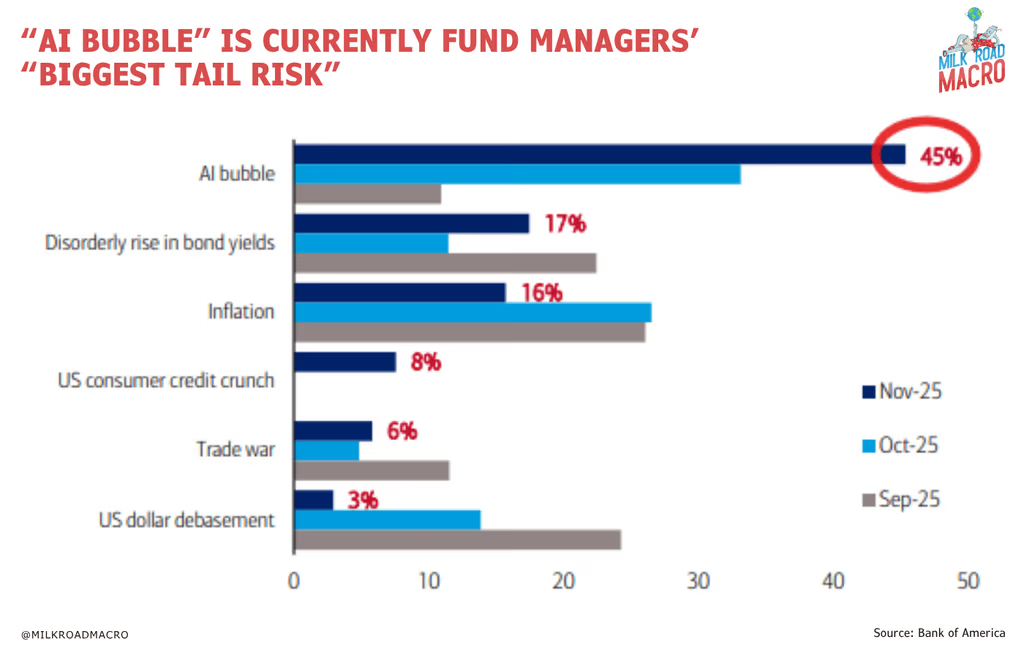Original Title: 6 reasons why risk assets are selling off
Original Author: Tomas (@TomasOnMarkets)
Translation|Odaily Planet Daily (@OdailyChina); Translator|Asher (@Asher0210)_ 
In the past few weeks, risk assets have almost simultaneously declined, with the S&P 500 down 5%, the Nasdaq down 8%, and Bitcoin also retracing about 30%. The market is filled with various concerns: Has the bubble ended? Is a new bear market forming? Is a larger-scale crash imminent?
So, what exactly has happened? The following will analyze six reasons for the recent sell-off of Bitcoin from a macro perspective.
1. Fear of Economic Growth
The so-called growth scare does not mean that the economy is really slowing down significantly or about to enter a recession, but rather that investors suddenly worry that the economic growth rate is declining faster than expected, leading to a rapid rise in "fear of weakening growth." This sentiment is often amplified quickly when some leading indicators show signs of weakening, prompting the market to reprice risk and triggering adjustments in risk assets, such as Bitcoin prices.
Currently, several growth-related indicators in the U.S. have shown signs of "turning down." From the trend of changes over the past four months, whether it is the "U.S. potential growth rate" that measures real-time growth, the "Citigroup Economic Surprise Index (CESI)" that reflects whether economic data exceeds expectations, or the "1-year U.S. inflation swap" that reflects market expectations for inflation over the next year, all have declined since early September, especially accelerating significantly in November. This trend is highly similar to previous rounds of growth scares (such as early 2025 and summer 2024).

Historically, growth scares are very common, occurring about once or twice a year. When economic indicators capture changes in growth rates and market participants begin to reallocate assets, a short-term decline in risk appetite often triggers a round of "normal-level" adjustments. Typically, in a typical growth scare, the S&P 500 will retrace about 5 to 10%, and the Nasdaq usually falls 5 to 15%, which aligns closely with the current market performance.
Of course, growth scares can also worsen and evolve into a more prolonged and severe economic slowdown or even recession. However, given the current economic environment, it seems more like a "normal fluctuation" rather than a precursor to recession. Although the market is adjusting due to short-term sentiment, it does not show signs of systemic decline overall.
2. Strengthening U.S. Dollar
In the past few weeks, the U.S. Dollar Index (DXY) has shown a clear strengthening trend, which is not a good sign for risk assets. The dollar weakened throughout the first half of 2025, providing strong support for global risk assets; however, since mid-September, the dollar has strengthened again, and market sentiment has subtly changed.

As the world's reserve currency, the strength of the dollar has a direct impact on the global economy. Currently, over 70% of global trade is priced in dollars, and more than 70% of global debt is linked to the dollar. When the dollar continues to strengthen, it effectively raises financing costs worldwide, forcing the real economy into a "tightening" mode, and overall liquidity becomes strained. Historical experience shows that a strengthening dollar often precedes adjustments in risk assets, serving as a leading indicator— the stronger the dollar, the harder it is for risk assets to maintain sustained performance.
Comparing the three-month changes in the dollar index with the three-month performance of the S&P 500 reveals that the dollar's rise often corresponds with a pullback in U.S. stocks. A similar pattern is also seen with Bitcoin, where the three-month changes in the dollar and Bitcoin's movements are almost mirror images (the chart below has inverted the dollar index and shifted it three months ahead). This indicates that the upward pressure of the dollar typically manifests in the prices of risk assets in the following weeks to months.

At this stage, what market bulls most hope to see is a renewed weakening of the dollar index. As long as the dollar continues to rise, the market's pressured environment will persist—this may also be one of the underlying forces behind the recent synchronized decline of Bitcoin and U.S. stocks.
3. Federal Reserve's Hawkish Stance
In recent weeks, the Federal Reserve's attitude has shown a clear hawkish shift. According to CME FedWatch data, the market's probability of a rate cut in December has plummeted from over 95% to 33% (the probability of a rate cut surged back to over 70% yesterday, currently reported at 67.3%). Previously, the market almost unanimously expected the Federal Reserve to cut rates in December, but at the latest FOMC meeting at the end of October, Chairman Powell clearly stated that a December rate cut is "not a done deal," marking a turning point in policy expectations and rapidly diminishing market confidence in a rate cut.
Although the Federal Reserve's policy stance in December will be more hawkish, the market still firmly believes that the central bank is still in a "easing cycle," which can be confirmed by the market's expectations for the "terminal rate." The so-called terminal rate is the rate level that the market expects the Federal Reserve will ultimately reach in this easing cycle.
Currently, the market's expected terminal rate is still around 3%, while the current federal funds rate is 4%, indicating that the market still expects about four more 25 basis point rate cuts in the future. Therefore, the market remains confident in the overall policy direction of the Federal Reserve, just with a short-term adjustment in pace.

4. Concerns About AI Bubble
Currently, market concerns about the so-called "AI bubble" are intensifying, with investors increasingly worried about the risks of excessive speculation and overvaluation in AI-related stocks. According to the latest global fund manager survey from Bank of America, about 45% of surveyed fund managers believe that the "AI bubble" is the biggest tail risk at present, while in another survey, more than half of fund managers believe that AI stocks already show signs of a bubble.

This concern about the "bubble" has driven recent market rotations away from AI and AI-related sectors. Investors are withdrawing from overvalued AI stocks and shifting towards more robust or defensive assets, leading to a certain degree of pullback in AI-themed stocks and some major indices. This adjustment not only affects the stock market but also indirectly impacts technology-related crypto assets and high Beta risk assets.
However, the market may be on the verge of a turnaround. The recent earnings report from AI leader Nvidia not only significantly exceeded expectations but also raised future growth forecasts. Nvidia not only has a huge market capitalization in the S&P 500 and Nasdaq but can also be seen as a barometer of AI enthusiasm. The earnings report indicated that "computational demand is accelerating and growing exponentially in both training and inference, and AI is rapidly expanding across various fields." This strong performance is expected to support the market's return to AI trading, alleviating short-term panic, and potentially boosting market bulls, with the rotation of funds in the AI sector possibly halting its decline and beginning to recover.
5. Withdrawal from Speculative Assets
Recently, the financial market has not only seen fund rotations away from AI stocks but also more signs of capital outflow from speculative assets, with investors turning towards relatively stable, low-volatility defensive assets. Although the declines in major indices like the S&P 500 and Nasdaq are still moderate, losses in other high-risk sectors are quite significant, with many speculative stocks falling more than 20%, and the decline is fierce like a tide.
This capital rotation has also impacted Bitcoin and the crypto market, as the market generally views crypto assets as "high Beta risk assets," which tend to bear greater pressure during downturns. In other words, when market risk appetite declines, high-risk assets are usually the first to be affected, and the pullback is more severe.
The current intensity of market capital rotation is very similar to the significant pullback period from February to April this year—indicating that the current market adjustment is not just a short-term reaction to a specific sector but reflects a systematic reallocation of funds between high-risk and defensive assets.
6. Systematic De-leveraging Strategies
The so-called systematic strategies refer to those quantitative funds that automatically buy and sell stocks according to established rules (usually related to trends and volatility). These strategies typically manage a very large amount of capital. From May to September this year, due to low market volatility and clear trends, systematic strategies bought a large number of stocks, accumulating hundreds of billions of dollars in positions. However, recently these strategies have completely "turned to selling," which may exacerbate the pullback pressure in the stock market, and Bitcoin, viewed as a "high Beta risk asset," will face even greater pressure and more significant declines.
Such de-leveraging behavior can sometimes create a "cascading effect," where systematic selling triggers more systematic selling. A similar situation occurred earlier this year from late March to early April, and this chain reaction could lead to a rapid market pullback or even amplify volatility.
Therefore, the market urgently needs a sufficiently strong catalyst to stop the spread of systematic selling. Perhaps Nvidia's strong Q3 earnings report can serve as this catalyst, providing support for the stock and crypto markets and alleviating short-term market panic.
免责声明:本文章仅代表作者个人观点,不代表本平台的立场和观点。本文章仅供信息分享,不构成对任何人的任何投资建议。用户与作者之间的任何争议,与本平台无关。如网页中刊载的文章或图片涉及侵权,请提供相关的权利证明和身份证明发送邮件到support@aicoin.com,本平台相关工作人员将会进行核查。




